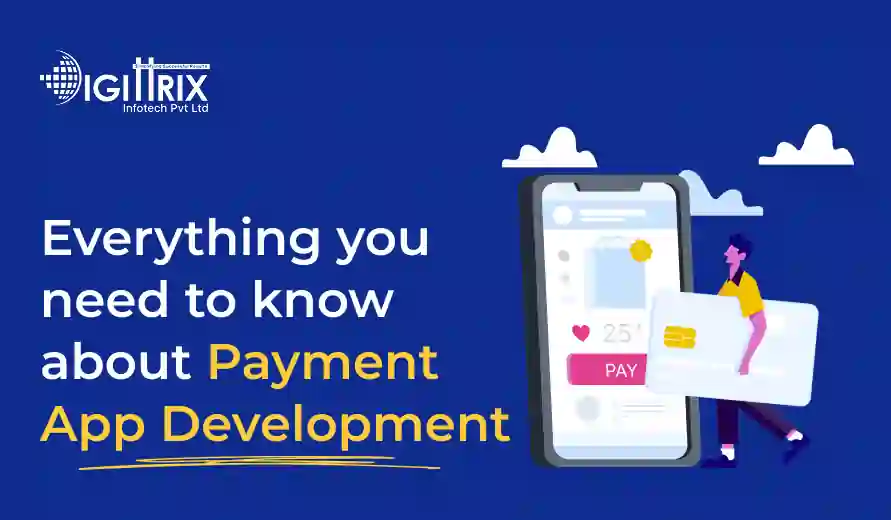The global market for payment app development increases by 24% each year, driven by mobile transactions, digital wallets, and secure payment options for users and businesses worldwide.
Highlights
With Over 14 years of Experience in the IT Field, Helping Companies Optimise there Products for more Conversions

In today’s digital age, payment apps are an essential part of daily life. From sending money and paying bills to shopping online or sharing funds with family and friends, these apps simplify financial management. Businesses, banks, and startups are increasingly developing payment apps to meet growing consumer demand. This article provides a comprehensive guide on payment app development, covering the process, key features, types, and important considerations for creating a mobile payment solution.
Looking to choose the right payment method? Check out Digittrix’s guide on subscription vs one-time payment gateways to make the best choice for your business!
A payment app is a mobile app that lets users perform financial transactions on their smartphones or tablets. It can serve various functions, such as transferring money between accounts, paying for goods and services, or managing digital wallets. Payment apps are not only convenient; they also provide speed and security, making them a popular choice over traditional payment methods.
Some popular payment apps include PayPal, Google Pay, and Venmo. These apps have changed the way people manage money, providing convenience for both individual users and businesses.
The demand for on-demand payment app development is growing quickly. Consumers today want fast, secure, and easy ways to manage money. Businesses are also looking for better payment options for their customers. By creating a payment app, companies can make transactions simpler, improve customer satisfaction, and stay competitive in the digital market.
Payment app development helps businesses reach more customers, reduce cash dependence, and process transactions efficiently. For startups and financial institutions, a well-designed payment app can build a strong foundation for financial services.
Payment apps can be classified into different types depending on their features and target users.
Peer-to-peer (P2P) payment apps let users send money directly to others. Examples include Venmo and Cash App. These apps are useful for personal transactions, allowing quick transfers without the need for cash or checks.
Mobile wallets securely store users’ card information and allow payments through smartphones. Examples include Google Pay and Apple Wallet. Mobile wallets are frequently used for online shopping, in-store purchases, and digital transactions.
These apps are designed for businesses to manage online payments from customers. Payment gateway apps connect with e-commerce platforms to facilitate smooth and easy payment transactions for products and services.
As digital currencies grow in popularity, cryptocurrency payment apps have emerged. They allow users to store, send, and receive cryptocurrencies like Bitcoin, Ethereum, and others.
Developing a payment app requires understanding key features that guarantee usability, security, and ease of use.
Secure registration is the first step in creating a payment app. Users should be able to sign up using their phone numbers, email addresses, or social media accounts. Employing strong authentication methods, like OTP verification, fingerprint scans, or facial recognition, improves security.
A digital wallet enables users to store funds, cards, and other payment methods. It offers a centralized platform for managing transactions and is vital for any payment app.
Users should be able to view detailed records of their transactions. A clear and organized transaction history helps users track their spending, monitor payments, and keep financial records.
Payment apps should offer a variety of payment options, such as credit/debit cards, net banking, UPI, QR code payments, and digital currencies. Providing a range of payment methods enhances user convenience.
Security is important when building a payment app. Encryption, secure servers, fraud detection, and two-factor authentication are key to safeguarding user data and stopping unauthorized transactions.
Real-time notifications and alerts for transactions, payments, or app activity enhance transparency and keep users updated on their account status.
Many payment apps provide features to pay bills, recharge mobile plans, or purchase items directly within the app. These features increase the app’s usefulness and draw in more users.
A strong support system is crucial for resolving user questions and issues. Incorporating chat support, FAQs, or help centers within the app guarantees users can get assistance when necessary.
Developing a payment app involves multiple stages. A systematic approach guarantees the app aligns with business goals and user expectations.
Before starting development, understanding the market is crucial. Identify target users, analyze competitors, and assess demand for specific payment services. This research aids in defining app features and strategies.
List the essential functionalities needed in the app. Decide if the app will focus on peer-to-peer transactions, mobile wallet services, bill payments, or multiple features. Clear requirements help guide the development process.
Payment app development can utilize native, cross-platform, or hybrid approaches. Native apps are designed for specific platforms like Android or iOS, while cross-platform apps operate across multiple platforms. The choice depends on budget, timeline, and target audience.
A simple, clean, and user-friendly interface is crucial for payment apps. Users should be able to navigate the app effortlessly, access features quickly, and complete transactions without confusion.
The backend manages data, user accounts, and transactions, while the frontend provides the visual interface. Both parts must work together seamlessly for optimal app performance.
Payment gateways like PayPal, Stripe, or local banking services are integrated to handle financial transactions. Proper integration ensures secure and fast payment processing.
Testing is vital for identifying and fixing bugs, ensuring security, and confirming the app functions correctly on all devices. Quality assurance testing improves reliability and enhances user experience.
After testing, the app is prepared to launch on platforms such as the Google Play Store and the Apple App Store. Continuous maintenance, updates, and monitoring keep the app functioning properly and secure.
While developing payment apps can be rewarding, it also brings challenges that need to be tackled.
Payment apps manage sensitive financial data. Any breach can lead to loss of funds and trust. Protecting this data with encryption, robust authentication, and fraud detection is essential.
Financial transactions must follow strict regulations. Apps need to comply with local and international laws related to data protection, anti-money laundering, and financial security.
The payment app market is very competitive. To attract and retain users, it's crucial to stand out by providing unique features, an easy-to-use interface, and reliable services.
Integrating different payment methods, handling large transaction volumes, and providing quick processing can be technically challenging. Experienced development teams are essential for overcoming these obstacles.
Building trust is essential. Users need to feel confident that their money and personal details are secure. Clear policies, robust security, and reliable app performance all help establish trust.
Choosing a dependable custom app development company is essential for the success of a payment app. A proficient company will grasp business needs, create an intuitive app, and manage technical requirements effectively.
When choosing a company, consider the following factors:
Partnering with the right development team guarantees the app meets quality standards and provides a positive user experience.
The cost of developing a payment app depends on several factors, including app complexity, platform choice, features, and the expertise of the development team. Simple apps with basic features are less expensive, while more complex apps with advanced security, multiple payment options, and on-demand features tend to cost more.
Maintenance, updates, and server costs also add to the overall budget. Consulting with an app development company can give you a detailed cost estimate tailored to your needs.
Building a payment app provides numerous benefits for both businesses and users.
Payment apps are continually improving with technology. Some emerging trends include:
Businesses creating payment apps must stay up-to-date with trends to offer relevant and efficient solutions to users.
Curious about how on-demand grocery apps are transforming India's delivery market? Explore Digittrix’s latest insights on the rapid growth and impact of instant grocery delivery services across the country to understand the evolving landscape!
Payment app development has become an essential part of the digital economy. From individual users to businesses, these apps provide a fast, secure, and convenient way to manage financial transactions. By understanding the types of payment apps, their key features, development processes, challenges, and benefits, businesses can make informed decisions when investing in mobile app solutions.
Whether choosing on-demand payment app development or a broader financial solution, working with a professional custom app development company ensures a smooth and successful creation process. Through careful planning, security measures, and a focus on user experience, payment apps can become a powerful tool for business growth while offering convenience to users worldwide.
Focusing on mobile app development for payments helps companies streamline financial operations, build trust with users, and stay competitive in a growing digital market.
In today’s digital economy, a secure and user-friendly payment app can help your business process transactions quickly and safely. With the right features, such as an intuitive interface, fast payment processing, multiple payment options, and strong security, your app can deliver a smooth and convenient experience for users.
As a trusted custom app development company with over 14 years of experience, Digittrix offers modern solutions built with advanced technology, user-focused design, and secure architecture to support your business goals.
If you’re planning to create a mobile payment app for your business and need expert guidance, contact our team today. Call +91 8727000867 or email digittrix@gmail.com to schedule a consultation and kick off your project.

Do you need help in Mobile App development?




Join over 1500+ businesses we've already helped!
It is an application that allows users to send money, pay bills, shop online, or manage their finances directly from a smartphone or tablet.
Development time depends on complexity. Simple apps may take a few months, while apps with multiple features can take close to a year.
Important features include user authentication, transaction records, support for multiple payment methods, notifications, and customer assistance.
A skilled company handles design, secure transactions, server management, and ongoing maintenance to ensure smooth app performance.

©2025Digittrix Infotech Private Limited , All rights reserved.